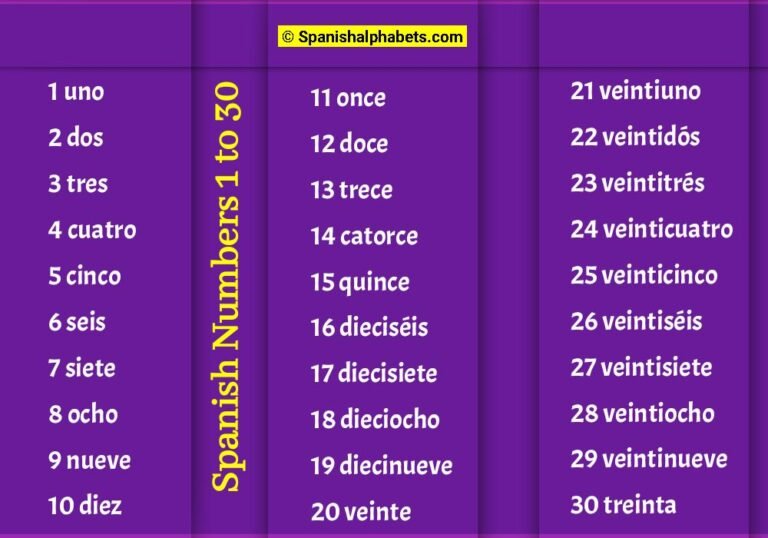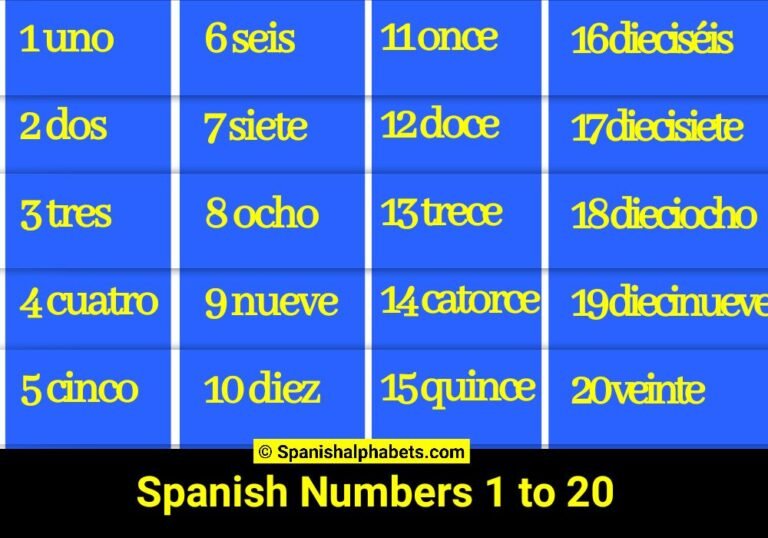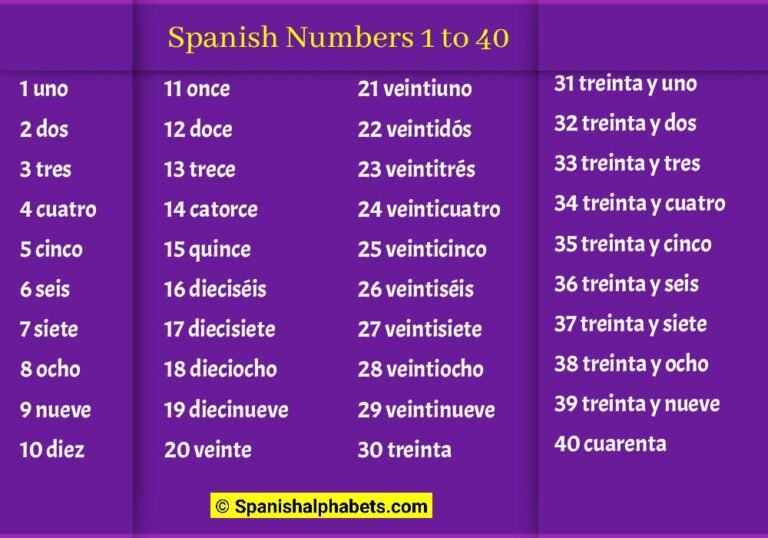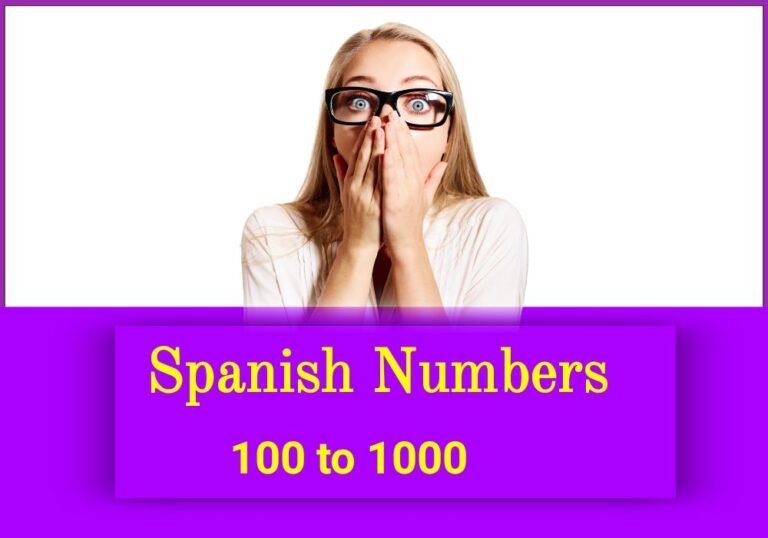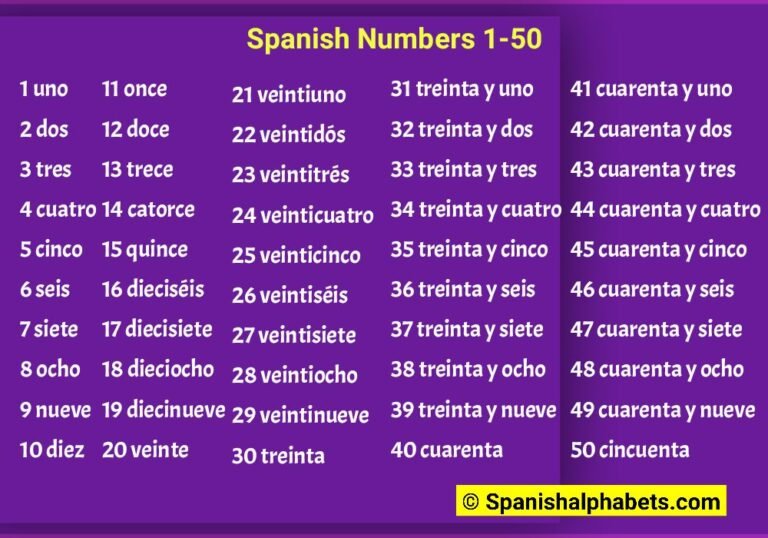Spanish Numbers 1 through 100 are the perfect way to quickly and easily learn all Spanish numbers. With clear instructions and step-by-step guidelines.
Are you looking to improve your Spanish skills? Check out Spanishalphabets.com, the best blog for learning Spanish numbers one through 100. With clear and concise explanations, our blog is perfect for beginners looking to grasp the basics.
Plus, we offer helpful tips and tricks for mastering those tricky pronunciations & spelling. So dive in today and start counting in Spanish like a pro!
Here, we provide a detailed breakdown of how to pronounce and spell Spanish numbers one through 100. This is an essential skill for anyone looking to improve their Spanish proficiency. With our help, you can master this tricky subject quickly!
How to Count to 100 in Spanish: A Comprehensive Table & Chart
Counting to 100 in Spanish is easier than it may seem. Some patterns can be followed, which makes it much more manageable. With practice, anyone can learn to count to 100 in Spanish.
To help, here is a comprehensive table and chart showing how to count to 100 in Spanish. Start at the number 1 and follow the pattern shown. With some practice, you’ll be counting like a native in no time!
| No. | In Spanish Spellings | English Pronunciation |
|---|---|---|
| 0 | cero | say-ro |
| 1 | uno | oo-no |
| 2 | dos | dose |
| 3 | tres | trace |
| 4 | cuatro | kwat-ro |
| 5 | cinco | sink-o |
| 6 | seis | saze |
| 7 | siete | see-yet-eh |
| 8 | ocho | och-o |
| 9 | nueve | new-eh-veh |
| 10 | diez | dee-ace |
| 11 | once | ohn-say |
| 12 | doce | dos-say |
| 13 | trece | treh-seh |
| 14 | catorce | ca-TOR-say |
| 15 | quince | KEEN-say |
| 16 | dieciséis | dee-AY-see-saze |
| 17 | diecisiete | dee-AY-see-see-AY-tay |
| 18 | dieciocho | dee-AY-see-och-o |
| 19 | diecinueve | dee-AY-see-new-EH-veh |
| 20 | veinte | Veh-een-tee |
| 21 | veintiuno | Veh-een-tee-oo-no |
| 22 | veintidós | Veh-een-tee-DOS |
| 23 | veintitrés | Veh-een-tee-TRACE |
| 24 | veinticuatro | Veh-een-tee-KWAT-ro |
| 25 | veinticinco | Veh-een-tee-SINK-o |
| 26 | veintiséis | Veh-een-tee-saze |
| 27 | veintisiete | Veh-een-tee-see-ay-tay |
| 28 | veintiocho | Veh-een-tee-OCH-o |
| 29 | veintinueve | Veh-een-tee-new-EH-veh |
| 30 | treinta | treh-een-tah |
| 31 | treinta y uno | treh-een-tah ee oo-no |
| 32 | treinta y dos | treh-een-tah ee DOS |
| 33 | treinta y tres | treh-een-tah ee tres |
| 34 | treinta y cuatro | treh-een-tah ee KWAT-ro |
| 35 | treinta y cinco | treh-een-tah ee SINK-o |
| 36 | treinta y seis | treh-een-tah ee saze |
| 37 | treinta y siete | treh-een-tah ee see-ay-tay |
| 38 | treinta y ocho | treh-een-tah ee OCH-o |
| 39 | treinta y nueve | treh-een-tah ee new-EH-veh |
| 40 | cuarenta | kwar-EN-tah |
| 41 | cuarenta y uno | kwar-EN-tah ee oo-no |
| 42 | cuarenta y dos | kwar-EN-tah ee DOS |
| 43 | cuarenta y tres | kwar-EN-tah ee tres |
| 44 | cuarenta y cuatro | kwar-EN-tah ee KWAT-ro |
| 45 | cuarenta y cinco | kwar-EN-tah ee SINK-o |
| 46 | cuarenta y seis | kwar-EN-tah ee saze |
| 47 | cuarenta y siete | kwar-EN-tah ee see-ay-tay |
| 48 | cuarenta y ocho | kwar-EN-tah ee OCH-o |
| 49 | cuarenta y nueve | kwar-EN-tah ee new-EH-veh |
| 50 | cincuenta | sink-KWEN-tah |
| 51 | cincuenta y uno | sink-KWEN-tah ee oo-no |
| 52 | cincuenta y dos | sink-KWEN-tah ee DOS |
| 53 | cincuenta y tres | sink-KWEN-tah ee tres |
| 54 | cincuenta y cuatro | sink-KWEN-tah ee KWAT-ro |
| 55 | cincuenta y cinco | sink-KWEN-tah ee SINK-o |
| 56 | cincuenta y seis | sink-KWEN-tah ee saze |
| 57 | cincuenta y siete | sink-KWEN-tah ee see-ay-tay |
| 58 | cincuenta y ocho | sink-KWEN-tah ee OCH-o |
| 59 | cincuenta y nueve | sink-KWEN-tah ee new-EH-veh |
| 60 | sesenta | seh-SEHN-tah |
| 61 | sesenta y uno | seh-SEHN-tah ee oo-no |
| 62 | sesenta y dos | seh-SEHN-tah ee DOS |
| 63 | sesenta y tres | seh-SEHN-tah ee tres |
| 64 | sesenta y cuatro | seh-SEHN-tah ee KWAT-ro |
| 65 | sesenta y cinco | seh-SEHN-tah ee SINK-o |
| 66 | sesenta y seis | seh-SEHN-tah ee saze |
| 67 | sesenta y siete | seh-SEHN-tah ee see-ay-tay |
| 68 | sesenta y ocho | seh-SEHN-tah ee OCH-o |
| 69 | sesenta y nueve | seh-SEHN-tah ee new-EH-veh |
| 70 | setenta | seh-TEHN-tah |
| 71 | setenta y uno | seh-TEHN-tah ee oo-no |
| 72 | setenta y dos | seh-TEHN-tah ee DOS |
| 73 | setenta y tres | seh-TEHN-tah ee tres |
| 74 | setenta y cuatro | seh-TEHN-tah ee KWAT-ro |
| 75 | setenta y cinco | seh-TEHN-tah ee SINK-o |
| 76 | setenta y seis | seh-TEHN-tah ee saze |
| 77 | setenta y siete | seh-TEHN-tah ee see-ay-tay |
| 78 | setenta y ocho | seh-TEHN-tah ee OCH-o |
| 79 | setenta y nueve | seh-TEHN-tah ee new-EH-veh |
| 80 | ochenta | och-EHN-tah |
| 81 | ochenta y uno | och-EHN-tah ee oo-no |
| 82 | ochenta y dos | och-EHN-tah ee DOS |
| 83 | ochenta y tres | och-EHN-tah ee tres |
| 84 | ochenta y cuatro | och-EHN-tah ee KWAT-ro |
| 85 | ochenta y cinco | och-EHN-tah ee SINK-o |
| 86 | ochenta y seis | och-EHN-tah ee saze |
| 87 | ochenta y siete | och-EHN-tah ee see-ay-tay |
| 88 | ochenta y ocho | och-EHN-tah ee OCH-o |
| 89 | ochenta y nueve | och-EHN-tah ee new-EH-veh |
| 90 | noventa | no-VEHN-tah |
| 91 | noventa y uno | no-VEHN-tah ee oo-no |
| 92 | noventa y dos | no-VEHN-tah ee DOS |
| 93 | noventa y tres | no-VEHN-tah ee tres |
| 94 | noventa y cuatro | no-VEHN-tah ee KWAT-ro |
| 95 | noventa y cinco | no-VEHN-tah ee SINK-o |
| 96 | noventa y seis | no-VEHN-tah ee saze |
| 97 | noventa y siete | no-VEHN-tah ee see-ay-tay |
| 98 | noventa y ocho | no-VEHN-tah ee OCH-o |
| 99 | noventa y nueve | no-VEHN-tah ee new-EH-veh |
| 100 | cien | see-EHN |
Whether you’re a beginner studying Spanish or need to brush up on your counting skills, this comprehensive guide will show you how to count from 1 to 100 in Spanish. Along with a table and chart for reference, we’ll also provide some key phrases and tips to help make your learning process as smooth as possible. Let’s get started with more details of up to 10!
How to Pronounce Spanish Numbers: A Guide from 1 to 100
If you’re new to learning Spanish, one of the first things you’ll need to know is how to pronounce the numbers from 1 to 100. This can seem daunting at first, but with some practice, it will become second nature.
Here are some tips for pronouncing Spanish numbers:
- The number 1 is pronounced “uno” (OO-noh).
- The number 2 is pronounced, “dos” (dohs).
- The number 3 is pronounced, “tres” (trees).
- The number 4 is pronounced “cuatro” (KWAH-troh).
- The number 5 is pronounced “cinco” (SEEN-koh).
Spanish numbers are easy to pronounce once you know the general rules. In this guide, we will go over how to pronounce Spanish numbers from 1 to 100.
To start, let’s look at the numbers 1-10. In Spanish, these are pronounced as follows:
- 1- uno
- 2- dos
- 3- tres
- 4- quatro
- 5- cinco
- 6- seis
- 7- siete
- 8- ocho
- 9- nueve
- 10- diez.
Now let’s move on to the teens. In Spanish, the teen numbers are all said with “ten” in front of them. So, for example, 13 would be said as “ten-three” or “trace.
Study Shows That Most Americans Can’t Spell Simple Spanish Numbers
A new study has found that most Americans need help to spell simple Spanish numbers. The University of California study found that only about one-third of Americans can correctly spell the numbers 1 to 100 in Spanish.
The study also found that American adults tend to struggle with spelling more complex words in Spanish, such as “cien” (100) and “quince” (15). This is likely because English and Spanish have different rules for spelling numbers.
While this may be a minor deal for everyday conversation, it could be a problem for Americans trying to learn or communicate with Spanish speakers.
So if you plan on traveling to a Spanish-speaking country, you should brush up on your number spelling before you go!
The good news is that there are some easy ways to improve your spelling skills. One tip is to practice writing out the numbers in Spanish as often as possible. You can also use mnemonic devices such as rhyming or making up stories to help you remember how to spell each number.
So why are Americans so bad at spelling simple Spanish numbers? Babbel’s experts say it could be because we use them sparingly daily.
How to Quickly Learn Spanish Numbers up to 100
In Spanish, numbers play an essential role in everyday conversation. Whether you’re telling time, counting money, or simply expressing how many of something there are, it’s essential to know your numbers up to 100.
Learning Spanish numbers can seem daunting, but it doesn’t have to be! With time and practice, you can quickly learn to count up to 100 in Spanish. Here are a few tips to help you get started:
- Start by learning the numbers 1-10. Once you know these, you can begin counting by 10s up to 100.
- Pay attention to the way numbers are pronounced in Spanish. For example, the number 13 is pronounced “trace,” not “treinta.”
- Practice counting out loud as often as possible. This will help embed the numbers in your memory so you can recall them more easily when speaking.
With a little effort, you’ll be able to master Spanish numbers quickly!
Achieve Spanish fluency with this one simple trick: counting to 100
Achieve Spanish fluency with this one simple trick–counting to 100. It may seem too easy to be accurate, but counting is a great way to learn Spanish. By counting to 100 in Spanish, you will not only learn the language but also gain a better understanding of the culture.
Counting is a great way to learn Spanish because it forces you to pay attention to pronunciation and intonation. When you are counting, you are practicing not only your speaking skills but also your listening skills. In addition, counting helps you to review basic grammar rules and vocabulary.
Achieve Spanish fluency with this one simple trick–counting to 100. It may seem too easy to be accurate, but counting is a great way to learn Spanish vocabulary and improve pronunciation.
Here’s how it works:
- Start by counting from 1 to 10 in Spanish.
- Do the same thing from 10 to 20.
- Once you’ve mastered those numbers, move on to 20 to 30, and so on, until you reach 100.
- As you count, listen carefully to the pronunciation of each number and repeat it out loud.
This will help you learn the correct way to say numbers in Spanish and give you some practice with other essential words and phrases. Plus, it’s a great way to review what you already know.
Concluding Points
Spanish is the second most spoken language in the world, with more than 470 million speakers. It is also the official language in 21 countries. Counting to 100 in Spanish can help you communicate with many people.
Spanish is the primary language for about 41 million people in the United States. It is also one of the country’s official languages. In the United Kingdom, there are about 3 million Spanish speakers.
Learning to count to 100 in Spanish can help you communicate with many people, whether traveling or living in a Spanish-speaking country. It can also be helpful if you have friends or family who speak Spanish.
In summary: In Spanish, the numbers from 1-10 are as follows: uno, dos, tres, cuatro, cinco, seis, siete, ocho, nueve, diez.
To say 11-19 in Spanish, you simply take the number 10 (diez) and add the appropriate number after it: once (11), doce (12), trece (13), catorce (14), quince (15), dieciséis (16), diecisiete (17), dieciocho (18), diecinueve (19). After 20 in Spanish is veintiuno for 21, veintidós for 22, and so on until veintinueve for 29.
My Advice: Start by learning the numbers 1-10. These are the most basic and essential numbers that you will use daily. Once you have these down, you can start adding more significant numbers.
Pay attention to the way numbers are pronounced in Spanish. This is one of the main differences between Spanish and English; it can trip up beginners.
FAQs
Spanishalphabets.com’s FAQs section is perfect for learning Spanish numbers one through 100. You can pick up the basics quickly and easily with clear and concise questions and answers.
This is the perfect resource for you! Not only does it provide a complete list of numbers, but it also includes related questions and answers. This makes learning easy and fun!
Question (1) – What are the numbers from 1 to 100 in Spanish?
Answer: In Spanish, the numbers from 1 to 100 have unique names. The number 1 is uno; the number 2 is dos; the number 3 is tres, and so on. The number 10 is diez, the number 20 is veinte, and the number 30 is treinta.
The numbers from 40 to 50 are cuatrocientos (40), cincuenta (50), sesenta (60), setenta (70), ochenta (80), noventa (90), and cien (100).
To form more significant numbers, combine the smaller numbers. For example, 21 in Spanish would be formed by saying “veintiuno” (veinte+uno). Similarly, 55 in Spanish would be “cincuenta y cinco” (cincuenta+y+cinco).
Question (2) – How do you spell numbers in Spanish?
Answer – In Spanish, there are two ways to spell out numbers: conventional and Spanish. Conventional methods are used more often in formal writing, such as essays and business documents.
In this system, numbers are spelled out as words from one to ten, and then numerals are used for 11 and up. So, “uno” is spelled out as “one,” “dos” as “two,” and so on.
The Spanish way of spelling numbers is used more often in everyday writing, such as emails and texts. In this system, numbers one through nine are spelled out as words, but 10 and up use numerals. So “uno” is still spelled out as “one,” but “10” is written as “1.
Question (3) – How do you say the numbers in the hundreds in Spanish?
Answer: When it comes to learning Spanish, one of the first things you need to know is how to say the numbers in the hundreds. While it may seem daunting, it’s pretty simple once you get the hang of it. Here’s a quick guide on how to say the numbers in the hundreds in Spanish.
To start, let’s take a look at the number 100. In Spanish, this number is pronounced as cien. So, if you wanted to say “100 years old,” you would say “cien años.”
The number 200 in Spanish is pronounced as docents. Similarly, 300 is pronounced as trescientos, and 400 is quatrocientos. 500 is pronouced as quinientos and 600 is seiscientos.
Question (4) – How do you count to 100 in Spanish?
Answer – In Spanish, 100 is written as “cien.” To count to 100 in Spanish, you first say the number in groups of tens. For example, from 1-10, you would say “uno, dos, tres, cuatro, cinco, seis, siete, ocho, nueve,” which means “one, two three four five six seven eight nine.”
Then you continue counting by saying “diez,” which means “ten,” then adding the numbers one through nine again. So 11-19 would be “diez y uno, diez y dos,” and so on. Once you reach 20, you start counting by twenties instead of tens. So 20-29 would be “veinte y uno, veinte y dos,” and so on.
Question (5) – How to spell 1 2 3 4 5 6 7 8 9 10 in Spanish?
Answer – In Spanish, the numbers 1, 2, 3, 4, 5, 6, 7, 8, 9 10 are spelled as follows: uno, dos, tres, cuatro, cinco, seis, siete, ocho, nueve, diez.
To spell these numbers out loud, you would say “oo-noh,” “dohs,” “trehs,” “kwah-troh,” “seen-koh,” “say-ees,” “see-eh-teh,” “oh-choh,” “nway-beh,” and “dyehs.” When writing these numbers in Spanish, they should be grouped in threes with commas between each set of three digits. For example, 1 2 3 4 5 6 7 8 9 10 would be written as 123,456,789.

